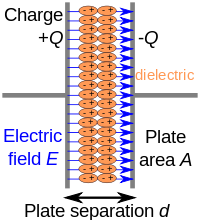
Photo from wikipedia
With electrical power generated from mechanical contact, triboelectric nanogenerators (TENGs) offer a promising route to realizing self-powered sensors. For effective usage, it is important to improve their limited power range… Click to show full abstract
With electrical power generated from mechanical contact, triboelectric nanogenerators (TENGs) offer a promising route to realizing self-powered sensors. For effective usage, it is important to improve their limited power range (0.1–100 mW/cm2) and this can be achieved by optimizing the output performance. Among the factors that confer higher performance are materials with a strong triboelectric effect together with low permittivity, but it is challenging to optimize both within a single material. This paper presents a solution to this challenge by optimizing a low permittivity substrate beneath the tribo-contact layer. Results are simulated over a range of substrate permittivities. The open circuit voltage is found to increase by a factor of 1.6 in moving from PVDF to the lower permittivity PTFE. Two TENG devices have been fabricated with $100\boldsymbol {\mu m}$ PET and PTFE substrates to compare performance. The experiments confirm that lowering the substrate dielectric constant (i.e. PET to PTFE) raises the open circuit voltage in line with simulation predictions.
Journal Title: IEEE Sensors Journal
Year Published: 2020
Link to full text (if available)
Share on Social Media: Sign Up to like & get
recommendations!